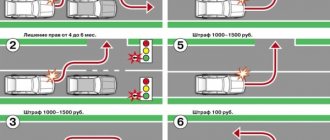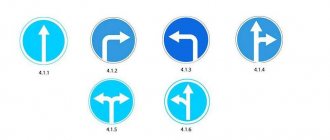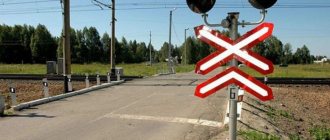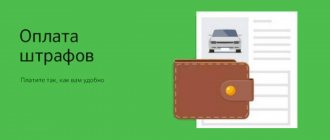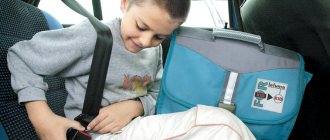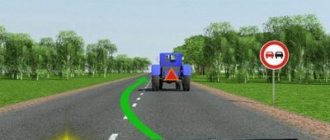Types of lane signs
“Driving in lanes” signs are a whole set of indicators indicating in which direction the driver can go. They are similar to each other: each has a white arrow on a blue background.
The traffic rules give a brief definition of these signs, but more precise information on their use and meaning is contained in GOST 52289-2004:
| Number | Meaning |
| 5.15.1 | They determine the direction at intersections and roundabouts, where high traffic intensity requires it. They indicate from which lane you are allowed to turn right or left, turn around, or go straight. They regulate only traffic flows in one direction. |
| 5.15.2 | |
| 5.15.7 | Shows the direction of travel if the road has an unequal number of opposite lanes or there are more than 4 of them. A sign with two arrows is often placed in areas where it is not always intuitive which direction it is allowed to go. |
Rules for moving vehicles
In general, the driver is prohibited from moving in the oncoming lane, as well as turning around and turning through double and single continuous markings. On a 3-lane road, the center lane is used for driving in both directions, overtaking, turning left and making U-turns. These maneuvers cannot be performed from the outer lanes.
How to move correctly within the boundaries of populated areas:
- You are allowed to drive in any lane in your direction. In heavy traffic, change lanes only to turn, make a U-turn, or go around an obstacle in order to find a parking or stop space (not to overtake).
- You can occupy tram tracks in your own direction, but only in heavy traffic (when other rows are filled with cars), for U-turns, turns and detours. In any case, you must not obstruct the tram. Signs 5.15.1/2 posted in front of intersections do not allow exit on the path.
- Do not cross solid lines between rows, change lanes only in areas with intermittent markings.
- Avoid driving directly from the turning lane and vice versa.
Special requirements apply for driving on country roads:
- You should drive as close to the right side of the road as possible, maintaining the distance between the lanes;
- Do not occupy the left lane when the right one is free.
Penalty for violating lane markings when changing lanes
Many drivers systematically cross a solid line when changing lanes, stand after a stop sign when the traffic light is red. For such violations they will have to pay a fine.
But there are also cases when you do not have to pay a fine. Let us consider in detail how to change lanes correctly and without problems, so as not to receive a fine.
Changing lanes across a continuous line in the opposite direction. When a driver begins to overtake and crosses a solid line, he faces a fine. This is one of the most common traffic violations. In particular, such violations occur on a single-lane highway, when the driver wants to quickly overtake the car in front. But a fine is not the most severe administrative punishment in this case.
There is also a situation where a violator’s driver’s license may be taken away. And you can lose your driver’s license for this type of violation when the culprit changes lanes across a solid line again. In such a situation, the rights are withdrawn for a year. But if the violation was captured on camera, you will have to pay a fine.
It is possible to cross a solid line only if it marks the boundaries of parking spaces. When crossing a solid lane and entering the oncoming lane, the fine will be 5,000 rubles or 4 to 6 months of deprivation of a driver’s license.
Changing lanes across a continuous line in the same direction. A solid marking line can separate rows in the same direction. If the driver crosses a solid line in the same direction, he faces a fine of 500 rubles or a warning. But if a driver crossed a solid line and at the same time changed lanes into a bus lane, then he already faces a fine of 1,500 rubles. But it is quite possible to avoid a fine if crossing the solid line was urgent or forced. In this case, crossing the solid line would cause less harm.
Crossing one continuous line when changing lanes. Very often, cases arise when drivers leave their yard and find themselves on a two-way road, and the lanes are separated from each other by a solid line. It turns out that when changing lanes, the driver crosses a solid one. And this is already a gross violation of traffic rules, which gives the right to fine the driver in the amount of 1,000 to 1,500 rubles.
Bottom line. Today it is very easy to get a fine for crossing a solid line. You might even lose your driver's license.
You can also get a fine for stopping after the stop line. In this case, there is no need to go to the “blinking yellow” signal. It's better to release the gas pedal and stop. And on highways you shouldn’t overtake at all when crossing a solid line. After all, usually a solid line indicates a special section of the highway with a high concentration of accidents. You should also always obey the speed limit.
Current fine amounts
The following situations are in one way or another connected with a violation of the row and therefore a fine is always imposed for actions in this way. Current penalties today:
| Action, maneuver | Article of the Administrative Code | Collection amount, rub. |
| Violation of the rules for driving in lanes contrary to signs or markings | 12.16 p.m. 1 | 500 (or warning) |
| Rotate or pivot through continuous markings | 12.16 p.2 | 1000–1500 |
| Driving on a 1-lane road in the opposite direction | 12.16 h. 3 | 5000 (or deprivation of rights for 4–6 months) |
| The same thing, committed twice or more times within a year after repayment of the penalty for the first | 12.16 hours 3.1 | Imprisonment for a year (for a cell - collection of 5 thousand rubles) |
| Entering the oncoming lane to avoid obstacles | 12.15 h. 3 | 1000–1500 |
| Driving into oncoming traffic in other cases | 12.15 h. 4 | 5000 (or withdrawal of driving license for 4–6 months) |
| The same thing done a second time | 12.15 h. 5 | Imprisonment for a year (for a cell - collection of 5,000 rubles) |
Driving schoolhome traffic rules online
We have launched free distance learning on Youtube. Subscribe to our channel and watch video lectures.
The Code regarded violation of marking requirements in the same way as violation of sign requirements. Basically, at the minimum (a warning or a fine of 500 rubles), and TURNING LEFT, U-Turn, PARKING AND STOPPING are significantly more expensive.
The arrow on the roadway (marking 1.18) shows the only permitted direction of movement at the intersection.
If you turn right, the penalty is minimal - a warning or a fine of 500 rubles.
If you turn left or turn around, the fine is 1000-1500 rubles.
If you turn left into the yard before the intersection or turn around (through the solid center line!) it’s the same 1000-1500 rubles.
That is, everything is like with the signs: Code of Administrative Offenses.
Article 12.16. Part 2. Turning left or making a U-turn in violation of the requirements prescribed by road signs or road markings
shall
entail the imposition of an administrative fine in the amount of one thousand to one thousand five hundred rubles.
Absolutely nothing will change if we make the road multi-lane and put a double solid marking line in the middle.
Everything is the same - a fine of 1000-1500 rubles
for any attempt to turn left or turn around at an intersection, before or after an intersection, in violation of the marking requirements.
The options may be different, but the pattern is the same - severe punishment ( fine 1000-1500 rubles
) only for turning left or making a U-turn in violation of the marking requirements.
And if, for example, now you drive straight from the right lane, then you will be punished at a minimum ( a warning or a fine of 500 rubles
).
You just need to understand that driving on the roadway in the opposite direction is a completely different violation, and you won’t get away with 1,500.
Such an act is qualified as “driving into oncoming traffic in violation of the Rules”
, and the punishment is completely different -
a fine of 5,000 rubles or deprivation of rights for a period of 4 to 6 months
.
A yellow solid line drawn along the edge of the roadway (marking 1.4) indicates places where stopping vehicles is prohibited.
Any attempt to stop along this line is punishable in the same way as stopping in the area covered by sign 3.27 “Stopping is prohibited”: a fine of 1,500 rubles (in Moscow and St. Petersburg - 3,000 rubles).
The yellow broken line drawn along the edge of the roadway (marking 1.9) indicates places where parking is prohibited.
You can stop with impunity, but if you park, the penalty is the same as in the area covered by sign 3.28 “Parking is prohibited”: a fine of 1,500 rubles (in Moscow and St. Petersburg - 3,000 rubles).
In order not to be unfounded, I will quote the Code:
Code of Administrative Offences.
Article 12.16. Part 4. Failure to comply with the requirements prescribed by road signs or road markings prohibiting the stopping or parking of vehicles, except for the case provided for in Part 5 of this article, shall entail the imposition of an administrative fine in the amount of one thousand five hundred rubles.
Code of Administrative Offences.
Article 12.16. Part 5. The violation provided for in Part 4 of this article, committed in the federal city of Moscow or St. Petersburg
,
entails an administrative fine in the amount of three thousand rubles.
Such markings mark out parking spaces for disabled drivers.
Pretending to be a disabled person by sticking an identification mark on a car is unreliable; you also need a document confirming your disability. Otherwise, you can lose 10,000 rubles.
Firstly, they will be punished for parking in a place intended for disabled people ( a fine of 5,000 rubles
):
Code of Administrative Offences.
Article 12.19. Part 2. Violation of the rules for stopping or parking vehicles in places designated for stopping or parking vehicles of disabled people shall entail the imposition of an administrative fine on the driver in the amount of three thousand to five thousand rubles.
And, secondly, for the illegal installation of an identification sign “Disabled” (another 5,000 rubles):
Code of Administrative Offences.
Article 12.4. Part 2. Installation on a vehicle without appropriate permission of devices for giving special light or sound signals (except for security alarms) or illegal installation on a vehicle of an identification light of a passenger taxi or an identification sign “Disabled” shall entail the imposition of an administrative fine on citizens in the amount of five thousand rubles with confiscation of the subject of the administrative offense.
Driving beyond the stop line while waiting for a green traffic light today costs 800 rubles.
Code of Administrative Offences. Article 12.12. Part 2. Failure to comply with the requirement of the Traffic Rules to stop in front of a stop line indicated by road signs or road markings when there is a prohibitory traffic light signal or a prohibitory gesture from a traffic controller shall entail the imposition of an administrative fine in the amount of eight hundred rubles.
And, in fact, that’s all. Violation of the requirements of other marking lines is punishable by the minimum ( a warning or a fine of 500 rubles
).
What kind of overtaking will happen in the area of the sign?
Part 9.2 of the Russian Traffic Regulations states that overtaking in the oncoming lane is not allowed if the opposite rows are separated from each other by continuous double or single markings, or there is a prohibitory sign. Such a dangerous maneuver will result in a fine of 5,000 rubles for violating traffic in lanes under Article 12.15 Part 4 of the Code of Administrative Offences. or withdrawal of rights for 4–6 months. A secondary offense will definitely lead to deprivation of rights for 1 year, and if it was recorded by a camera, to a penalty of 5 thousand rubles.
As a rule, on roads with multi-flow traffic, signs are combined with markings. However, the traffic police warns that if there are no lines on the road, you should only follow the sign to determine the number of rows and direction of movement. The sign does not replace the markings. What does it mean?
Sign 5.15.7 can be installed on a road with two opposite lanes where the direction of flow is not always intuitive. This sign has two arrows (one pointing down, one pointing up) separated by a continuous white line. It does not mean that there are continuous markings on the road.
Advice! Sometimes outside the city on such roads the lanes are not separated by markings at all. Accordingly, overtaking on oncoming traffic is permitted in compliance with the requirements of Section 11 of the Traffic Regulations. The imposition of a fine for violating a row according to 12.15 Part 4 of the Code of Administrative Offenses (a fine of 5 thousand rubles, deprivation of driving license for 4–6 months) is unlawful. It needs to be challenged.
Parking, stopping and markings
Some of the fines relate to parking in one way or another. Motorists, even those who have barely received a license, literally every day face the problem of finding a free parking space, which is not at all easy. It would seem, what could happen if you put a car between cars, even if there is not much space between them? It’s okay if the car doesn’t enter the markings. If this happens, then in the near future a motorist who did not pay attention to the markings may receive a “letter of happiness.” Fine for violation provided for in Part 1 of Art. 12.16 Code of Administrative Offences, will be 500 rubles.
A larger fine will be imposed on the driver who decides to leave the car in a parking lot where parking is permitted only to residents of a particular area. A “foreigner” from another district who parks in such a zone faces a fine of 2,500 rubles.
A driver may lose from two to three thousand rubles for parking a car at the edges of exits and entrances into courtyards and adjacent areas or at rounded triangles. Such areas must remain open to provide a clear view to passing drivers.
Returning to the violation of markings, it is worth recalling that stopping on a traffic island will cost the same as running into a parking marking - 500 rubles. You can resort to stopping on an “island” only if staying in any other place could create a serious threat.
In 2021, the Anti-Terrorism Commission made a decision according to which in Moscow it is forbidden to leave a car without a license plate in permitted places (even in a paid parking lot!). Even if the ten-day period for car registration has not yet passed. Such vehicles will be transported to special parking lots. This rule is due to the fact that a car without a license plate can be used for terrorist purposes, which means that it can be potentially dangerous.
In what cases can you challenge a fine?
In order to cancel the punishment or mitigate it as much as possible, the offender must appeal it to the head of the State Traffic Inspectorate unit or in court within 10 days from the issuance of the decision. In the following cases, this must be done:
- If a fine for violating a sign is issued in the name of the owner, although in reality the offense was committed by the driver. In court or inspection, this is confirmed by a power of attorney to drive a car, a leasing agreement, testimony of witnesses, etc.
- If the wrong maneuver was made under extreme circumstances, for example to avoid an accident. And if the harm prevented is greater than actually caused by the driver.
- If the traffic police inspector, when registering a violation of the “Direction of traffic in lanes” sign, made gross procedural errors: for example, he did not involve two witnesses and did not make a video recording.
Attention! “Driving in lanes” signs are not prohibitive. They only show the number of rows and the direction of flow on each.
Without median strips 1.1 or 1.3 it is not prohibited to change lanes into oncoming traffic for a turn, U-turn or other maneuvers. Then the driver must follow the general rules of overtaking - section 11 of the Russian Federation Traffic Regulations.
This must be taken into account if the traffic police inspector unlawfully issues a protocol for driving into oncoming traffic and threatens with deprivation of rights. Practice shows that this happens very often, but the courts mostly side with the drivers.
